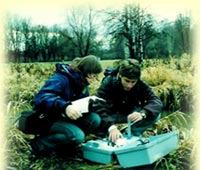Workshop for Local Business Leaders, Lithuania, February 2005
Health and safety concerns contributed to a European Union mandate requiring closure of two Chernobyl-type nuclear reactors in Visaginas, Lithuania. This was a pre-condition for Lithuania’s entry into the EU. One of the reactors was shut down in early 2005, and the second is scheduled for closure in 2008. The two economic pillars of Visaginas’ economy and the identity of its population of 28,000 are being toppled. When European Union residents turned on their lights so that astronauts could see their celebration of the Union from high above the Earth, Visaginas went into darkness to express its sense of being a victim of the EU. Such is the economic and social context surrounding the "More Effective and Sustainable Business” seminar that ECOLOGIA conducted in Visaginas on February 25, 2005.
For ECOLOGIA, this seminar is part of an organizational commitment to sustainable development and to a long-term program implementing this concept in Lithuania. More specifically, the seminar represents one outcome of a May 2004 mini-workshop we conducted as a pilot project of ECOLOGIA’s Problem Solving For Sustainable Development (PSSD) initiative.
This seminar was designed by a Visaginas community leader who attended an earlier ECOLOGIA workshops. The goal of the seminar was to increase the Visaginas business community’s understanding of sustainable development, and to support implementation of the Visaginas Strategic Plan for Sustainable Development.
The fifteen workshop participants included primarily small and medium sized local businesses, with the exception of a director of a large construction company, and the local store manager for a large Lithuanian supermarket chain. All were males. Most were Russians in their late forties or fifties. The majority were owner operators. Virtually all spent their adult lives in a closed Soviet-built city where the economy was totally dependent on a single industry and where all-important economic decisions where made from above and investment capital was supplied by Moscow. The goal of building new nuclear reactors and returning “the good old days” permeates the community and its economic aspirations. Having said that, we have seen the emergence of new thinking about economics and business. The weaving of sustainable development principles in the Municipal Strategic Plan documents this. On balance we must state that the seeds of real entrepreneurialism exist side by side with “Soviet” attitudes within the community and individuals. In this sense, Visaginas represents the complex business culture of many transition countries.
ECOLOGIA staff spent weeks preparing seminar materials. We focused on case studies and concepts that would be understandable by and compelling for business leaders in Visaginas
Seminar staff included:
- Randy Kritkausky - ECOLOGIA’s president, who has been involved in supervising ECOLOGIA programs in Visaginas since 1999. He has presented at several previous workshops for Visaginas community leaders. He is also active in outlining ECOLOGIA’s program objectives in the realm of international standards making.
- Neil and Judy Bicknell- Both are chartered financial analysts with broad experience in corporate investment and acquisitions. They have an in depth understanding of the information services industry. Both are part time residents of Vermont and are familiar with its corporate social responsibility business culture and branding.
Throughout the seminar we used the term “sustainable development” very broadly, including both social and environmental aspects of business decision-making. It was therefore easy to use “sustainable development” and “corporate social responsibility” as interchangeable terms – both linked to the concept of a “triple bottom line”.
Throughout the five hour presentation we presented summary case studies on a variety of companies practicing sustainable development and corporate social responsibility including:
Interface Carpet- a carpet manufacturer based in Atlanta Georgia that completely re-engineered its manufacturing process to dramatically reduce the use of toxic dyes and resins. It then transformed its marketing by becoming a service industry leasing carpet rather than a manufacturer selling carpet. This case study is widely used in books on sustainable development and corporate social responsibility.
Alcan – a giant aluminum producer and aluminum products company with operations in over 60 countries. Their annual corporate reports and sustainable development report were provided to workshop participants as examples of ambitious engagement of investors and the public.
Nike – a company whose athletic wear experienced a crisis when its sweatshop practices threatened to undermine one of the most valuable brand names in marketing.
Several small and medium sized businesses known to the presenters. Most were Vermont based and many belong to the Vermont Businesses for Social Responsibility (VBSR) network. VBSR and “Made in Vermont” regional branding were extensively discussed as collective regional variations on large corporate branding efforts.
Neil Bicknell presented a comparative case study of two large supermarket chains. One was Albertsons, a giant conventional supermarket chain. The other was Whole Foods, a much smaller chain, by sales volume, specializing in organic foods. A few statistics on sales volume, profit margin, percentage return on investment, and market value of the corporation dramatized the economic advantages of socially responsible businesses who engage in the business selling value-added products with comparatively larger profit margins.
We presented extensive information about how businesses collectively contribute to a regional brand that then adds value to products. We explained how Vermont VBSR conferences and meetings allow members to share information and business development strategies. This argument was supported by workshop materials (pens, folders, pads,etc.) all of which pointed to unique Vermont businesses who had high value added products. Holding physical manifestation of this in their hands appeared to help make the point.
The final half hour of the workshop appears to have brought us to the point of, at least temporarily fulfilling our first objective – developing enthusiasm for sustainable development. Clearly several workshop participants became enthusiastic only because they saw our proposed pathway as a “nothing to lose” alternative pathway to investment (or grants). Others showed signs of connecting with these principles on a deeper level, really “getting it”. Our local partner had noted that many of these businessmen had the economic resources needed to “escape” Visaginas and seek a better life. Yet they remain in Visaginas.
We are reminded of the one startling realization that we had preparing for the workshop. Over and over in one case study after another, hard nosed CEOs were compelled to experiment with SD and CSR because they were captured by the vision of making a positive contribution to their local or global community. In our standards work and in our implementation work, we should never underestimate the ability of a compelling idea to be part of the formula for social and economic transition. Wedding economic development to social and economic improvement in one’s community may enhance and energize progress in all of the inter-related sectors.
|



